Research on the Crushing of Reinforced Concrete Two-Way Slabs by Pulse Power Discharge Technology
Abstract
:1. Introduction
2. Methods and Models
2.1. Methods
2.2. Concrete Material Model
2.2.1. Tensile and Compressive Constitutive Relation of Concrete
2.2.2. Damage Factor
2.2.3. Dynamic Amplification Factor
2.3. Establishment of the Slab Model
2.4. The Material Model of Steel
2.5. Establishment of the Reinforcement Model
2.6. Equivalence of Impact Loads
2.6.1. CONWEP Model
2.6.2. Equivalence of Shock Pressure
2.7. Simulation of Concrete Crack Propagation Based on Cohesive Force Model
3. Model Verification
3.1. Model Test
 . The specific crushing method was to pre-drill the reinforced concrete slab 300 mm or 400 mm apart, and so the distance from the outermost row hole to the edge of the slab was 200 mm, the aperture was 40 mm, the hole depth was 110 mm, and this hole was filled with tap water. A copper wire was wound around the electrode and inserted into the borehole to generate pulsed power by releasing high voltage electricity. The mechanical properties of concrete and reinforcement are shown in Table 1 and Table 2. The holes were numbered B1 to B6. The spacing between drilling holes B1 and B3 was 300 mm, and the spacing between drilling holes B4 and B6 was 400 mm. For concrete strength grades, slabs B1 and B4 were C20, slabs B2 and B5 were C30, and slabs B3 and B6 were C40. The parameters of the test were the discharge voltage and the number of copper wires. The discharge voltage was 40 kV, 60 kV, 80 kV, and 100 kV, and the number of copper wires was 30, 40, 50, and 60.
. The specific crushing method was to pre-drill the reinforced concrete slab 300 mm or 400 mm apart, and so the distance from the outermost row hole to the edge of the slab was 200 mm, the aperture was 40 mm, the hole depth was 110 mm, and this hole was filled with tap water. A copper wire was wound around the electrode and inserted into the borehole to generate pulsed power by releasing high voltage electricity. The mechanical properties of concrete and reinforcement are shown in Table 1 and Table 2. The holes were numbered B1 to B6. The spacing between drilling holes B1 and B3 was 300 mm, and the spacing between drilling holes B4 and B6 was 400 mm. For concrete strength grades, slabs B1 and B4 were C20, slabs B2 and B5 were C30, and slabs B3 and B6 were C40. The parameters of the test were the discharge voltage and the number of copper wires. The discharge voltage was 40 kV, 60 kV, 80 kV, and 100 kV, and the number of copper wires was 30, 40, 50, and 60.3.2. Comparison between Experimental Results and Simulation Results
4. Results
4.1. Analysis of the Whole Process of Reinforced Concrete Slab Loading
4.2. Influence of Reinforcement Diameter on Cracks of Reinforced Concrete Slab
4.2.1. Influence of Reinforcement Diameter on Edge Crack Width w1
4.2.2. Influence of Reinforcement Diameter on Crack Width w2 between Edge Holes
4.2.3. Influence of Reinforcement Diameter on Crack Width w3 between Internal Holes
4.3. Influence of Reinforcement Spacing on Cracks of Reinforced Concrete Slab
4.3.1. Influence of Reinforcement Spacing on Edge Crack Width w1
4.3.2. Influence of Reinforcement Spacing on Crack Width w2 between Edge Holes
4.3.3. Influence of Reinforcement Spacing on Crack Width w3 between Internal Holes
4.4. Influence of Reinforcement Spacing on Cracks of Reinforced Concrete Slab
5. Discussion
6. Conclusions
- (1)
- The CONWEP method was used to simulate the impact load produced by PPD and the cohesive force model was used to simulate the development of cracks. By comparing the results of the PPD crushing test and simulation analysis, the relative errors of the test value and simulation analysis value of crack width were less than 10%. It shows that the finite element model has good accuracy in regard to analyzing the crack width of reinforced concrete slabs crushed by PPD.
- (2)
- According to the different degrees of concrete constraint on cracks, it can be divided into three categories according to its position in the slab: edge cracks, cracks between edge holes and cracks between central holes. The order of crack width in the same slab under the same conditions is cracks between edge holes > edge cracks > cracks between internal holes.
- (3)
- The amount of reinforcement in the slab has a great influence on the crushing effect of PPD. When the reinforcement spacing was reduced from 300 mm to 100 mm, the width of edge cracks, cracks between edge holes, and cracks between internal holes were reduced by 21.33%, 16.15%, and 31.40%, respectively. When the reinforcement diameter increased from 6 mm to 14 mm, the three crack widths decreased by 23.45%, 14.28%, and 23.76%. The increase in concrete strength also reduced the crack widths. When the concrete strength grade increased from C30 to C50, the crack widths decreased by 10~25%.
- (4)
- Taking the diameter and spacing of reinforcements and strength of concrete as independent variables, a unified formula for calculating the crack width of fractured reinforced concrete slabs with PPD was established, and the calculation coefficients for the width of edge cracks, cracks between edge holes, and cracks between internal holes were given, respectively. The goodness of fit R2 of statistical formula is above 0.88.
- (5)
- In this paper, a simulation analysis of the square bidirectional slab with a single bottom reinforcement was conducted. The PPD crushing effect of the reinforced concrete slab with an upper and lower double reinforcement mesh and each aspect ratio will be the focus of the next research.
Author Contributions
Funding
Data Availability Statement
Conflicts of Interest
References
- de Andrade Salgado, F.; de Andrade Silva, F. Recycled aggregates from construction and demolition waste towards an application on structural concrete: A review. J. Build. Eng. 2022, 52, 104452. [Google Scholar] [CrossRef]
- Allam, A.S.; Nik-Bakht, M. From demolition to deconstruction of the built environment: A synthesis of the literature. J. Build. Eng. 2023, 64, 105679. [Google Scholar] [CrossRef]
- He, Z.; Han, X.; Zhang, M.; Yuan, Q.; Shi, J.; Zhan, P. A novel development of green UHPC containing waste concrete powder derived from construction and demolition waste. Powder Technol. 2022, 398, 117075. [Google Scholar] [CrossRef]
- Abina, A.; Puc, U.; Zidanšek, A. Challenges and opportunities of terahertz technology in construction and demolition waste management. J. Environ. Manag. 2022, 315, 115118. [Google Scholar] [CrossRef] [PubMed]
- Kumar, A.; Singh, G.J.; Raj, P.; Kumar, R. Performance of Quality-Controlled Recycled Concrete Aggregates. ACI Mater. J. 2024, 121, 17. [Google Scholar] [CrossRef]
- Li, Y.; Li, M.; Sang, P. A bibliometric review of st.udies on construction and demolition waste management by using CiteSpace. Energy Build. 2022, 258, 111822. [Google Scholar] [CrossRef]
- Li, X.; Shi, H.; Hu, J.; Wu, J.; Li, X.; Qiu, A. A numerical model for the electrical and shock wave characteristics of underwater pulsed spark discharge. J. Appl. Phys. 2024, 135, 033302. [Google Scholar] [CrossRef]
- Liu, W.; Zhang, Y.; Zhu, X.; Feng, W. Numerical simulation study of rock breaking mechanism by high voltage electric pulse. Int. J. Min. Sci. Technol. 2023, 8, 642–653. [Google Scholar] [CrossRef]
- Ouyang, S.; Li, C.; Du, L.; Li, X.; Lai, Z.; Peng, T.; Han, X.; Cao, Q.; Li, L. Electromagnetic forming of aluminum alloy sheet metal utilizing a low-frequency discharge: A new method for attractive forming. J. Mater. Process. Technol. 2021, 291, 117001. [Google Scholar] [CrossRef]
- Huang, W.; Chen, Y. The application of high voltage pulses in the mineral processing industry—A review. Powder Technol. 2021, 393, 116–130. [Google Scholar] [CrossRef]
- Wang, J.; Xue, Q.; Du, X.; Cao, Y.; Yu, J.; Zhou, P.; Jiang, H. Study on the unplugging technology through electric explosion controllable shock wave. J. Energy Resour.-ASME 2021, 143, 053005. [Google Scholar] [CrossRef]
- Kuznetsov, Y.I.; Vazhov, V.F.; Zhurkov, M.Y. Electrical breakdown of solid dielectrics and rocks on the trailing edge of a voltage pulse. Russ. Phys. J. 2011, 54, 410–415. [Google Scholar] [CrossRef]
- Vogler, D.; Walsh, S.D.C.; Saar, M.O. A numerical investigation into key factors controlling hard rock excavation via electropulse stimulation. J. Rock Mech. Geotech. 2020, 12, 793–801. [Google Scholar] [CrossRef]
- Liu, W.; Zhang, Y.; Luo, Y.; Zhu, X. Generation mechanism of plasma channels for high-voltage electric pulses in rock. Acta Petrol. Sin. 2023, 44, 684–697. [Google Scholar] [CrossRef]
- Cho, S.H.; Cheong, S.S.; Yokota, M.; Katsuhiko, K. The dynamic fracture process in rocks under high-voltage pulse fragmentation. Rock Mech. Rock Eng. 2016, 49, 3841–3853. [Google Scholar] [CrossRef]
- Liu, W.; Zhang, Y.; Zhu, X. The partial electrical breakdown mechanism by high voltage electric pulses in multi-fractured granite. Geomech. Energy Environ. 2023, 34, 100459. [Google Scholar] [CrossRef]
- Lu, X.; Pan, Y. Theoretical Study on characteristics of discharge plasma in Water. Chin. J. Basic Eng. Sci. 2000, 8, 7. [Google Scholar] [CrossRef]
- Wong, T.; Timoshkin, I.; MacGregor, S.; Wilson, M.; Given, M. Dielectric Interfaces in High-Voltage Technology: Overview and Theoretical Approaches to the Modeling of Functional and Breakdown Behavior. IEEE Electr. Insul. Mag. 2023, 39, 34–49. [Google Scholar] [CrossRef]
- Lu, H.; Liu, Y.; Nie, B.; Nie, B.; Chen, X.; Xu, X. Crack Propagation Characteristics of Coal Samples Utilizing High-Voltage Electrical Pulses. ACS Omega 2021, 6, 34395–34405. [Google Scholar] [CrossRef]
- Li, C.; Duan, L.; Tan, S.; Chikhotkin, V.; Fu, W. Damage model and numerical experiment of high-voltage electro pulse boring in granite. Energies 2019, 12, 727. [Google Scholar] [CrossRef]
- Liu, K.; Zhang, H.; Cai, Z.; Yu, Q.; Wang, X.; Chen, Y.; Fu, H. Rock breaking characteristics of cyclic electrohydraulic shockwaves. J. Petrol. Sci. Eng. 2022, 210, 110024. [Google Scholar] [CrossRef]
- Xiong, L.; Liu, Y.; Yuan, W.; Huang, S.; Liu, H.; Li, H.; Lin, F.; Pan, Y. Experimental and numerical study on the cracking characteristics of repetitive electrohydraulic discharge shock waves. J. Phys. D Appl. Phys. 2020, 53, 495502. [Google Scholar] [CrossRef]
- Yu, Q.; Zhang, H.; Yang, R.; Cai, Z.; Liu, K. Experimental and numerical study on the effect of electrohydraulic shock wave on concrete fracturing. J. Petrol. Sci. Eng. 2022, 215, 110685. [Google Scholar] [CrossRef]
- Liu, Z.; Xu, C.; Fu, Y.; Wang, P.; Zou, X.; Wang, X. Molecular dynamics study of liquid–vapor transition in underwater electrical wire explosion. Phys. Plasmas 2022, 29, 123503. [Google Scholar] [CrossRef]
- Yuan, W.; Han, R.; Li, P.; Cao, Y.; Li, C.; Zhang, Y. Evolution of underwater shock wave in far-field regime of electrical wire explosion system over wide range of electric pulse energy. Exp. Therm. Fluid Sci. 2023, 149, 111022. [Google Scholar] [CrossRef]
- Zhao, P.; Guo, J.; Yan, G.; Zhu, G.; Zhu, X.; Zhang, Z.; Zhang, B. A novel and efficient method for resources recycling in waste photovoltaic panels: High voltage pulse crushing. J. Clean. Prod. 2020, 257, 120442. [Google Scholar] [CrossRef]
- Song, B.P.; Zhang, M.Y.; Fan, Y.; Jiang, L.; Kang, J.; Gou, T.; Zhang, C.; Yang, N.; Zhang, G.; Zhou, X. Recycling experimental investigation on end of life photovoltaic panels by application of high voltage fragmentation. Waste Manag. 2020, 101, 180–187. [Google Scholar] [CrossRef] [PubMed]
- Yan, F.; Xu, J.; Peng, S.; Zou, Q.; Zhou, B.; Long, K.; Zhao, Z. Breakdown process and fragmentation characteristics of anthracite subjected to high-voltage electrical pulses treatment. Fuel 2020, 275, 117926. [Google Scholar] [CrossRef]
- Yan, F.; Xu, J.; Peng, S.; Zou, Q.; Li, Q.; Long, K.; Zhao, Z. Effect of capacitance on physicochemical evolution characteristics of bituminous coal treated by high-voltage electric pulses. Powder Technol. 2020, 367, 47–55. [Google Scholar] [CrossRef]
- Lay, D.; Shi, F.; Antonio, C. Evaluation of a novel electrode design for high voltage pulse ore pre-concentration. Miner. Eng. 2023, 201, 108239. [Google Scholar] [CrossRef]
- Qin, Y.; Han, Y.; Gao, P.; Li, Y.; Yuan, S. Pre-weakening behavior of magnetite quartzite based on high-voltage pulse discharge. Miner. Eng. 2021, 160, 106662. [Google Scholar] [CrossRef]
- Qin, Y.; Han, Y.; Gao, P.; Li, Y.; Yuan, S. Characterization of chalcopyrite ore under high voltage pulse discharge: Particle size distribution, fractal dimension, specific energy consumption, grinding kinetics. Miner. Eng. 2022, 184, 107631. [Google Scholar] [CrossRef]
- Yan, G.; Zhang, M.; Sun, Z.; Zhao, P.; Zhao, B. Research on high voltage pulse breakage technology. Part 1: The breakdown characteristics of water. Miner. Eng. 2024, 205, 108478. [Google Scholar] [CrossRef]
- Yin, T.; Liu, C.; Chen, Y.; Zhuang, D.; Wu, Y.; Dai, H.; Su, J. Experimental and numerical study on the facture behavior of Heated-Granite subjected to High-Voltage electric pulse. Eng. Fract. Mech. 2024, 299, 109935. [Google Scholar] [CrossRef]
- Yudin, A.S.; Kuznetsova, N.S.; Bakeev, R.A.; Zhgun, D.V.; Stefanov, Y.P. Destruction of reinforced concrete by electric impulse discharges: Experiment and simulation. AIP Conf. Proc. 2017, 1909, 020234. [Google Scholar] [CrossRef]
- Tanaka, S.; Nishi, M.; Yamaguchi, M.; Bataev, I.; Hokamoto, K. Simultaneous initiation of nitromethane in two holes by pulsed wire discharge for crack control of a concrete block. J. Dyn. Behav. Mater. 2020, 6, 53–63. [Google Scholar] [CrossRef]
- Uenishi, K.; Yamachi, H.; Yamagami, K.; Sakamoto, R. Dynamic fragmentation of concrete using electric discharge impulses. Constr. Build. Mater. 2014, 67, 170–179. [Google Scholar] [CrossRef]
- Wang, X.; Li, N.; Wang, W. Experimental study on crushing of concrete slabs by high-voltage pulse discharge. Constr. Build. Mater. 2023, 401, 132951. [Google Scholar] [CrossRef]
- Wang, X.; Du, J.; Li, Q. Experimental study on crushing of concrete columns by high voltage pulse discharge. Case Stud. Constr. Mater. 2022, 16, e01090. [Google Scholar] [CrossRef]
- Wang, X.; Liu, P.; Sun, Y.; Wang, W. Study on breaking concrete structures by pulse power technology. Buildings 2022, 12, 274. [Google Scholar] [CrossRef]
- Zhu, X.; Luo, Y.; Liu, W.; He, L.; Gao, R.; Jia, Y. On the mechanism of high-voltage pulsed fragmentation from electrical breakdown process. Rock Mech. Rock Eng. 2021, 54, 4593–4616. [Google Scholar] [CrossRef]
- Zhu, X.; Chen, M.; Liu, W.; Luo, Y.; Hu, H. The fragmentation mechanism of heterogeneous granite by high-voltage electrical pulses. Rock Mech. Rock Eng. 2022, 55, 4351–4372. [Google Scholar] [CrossRef]
- Li, Y.; Liu, J.; Feng, B.; Zhang, X.; Zhang, M.; Xiao, H.; He, M.; Shi, F. Numerical modeling and simulation of the electric breakdown of rocks immersed in water using high voltage pulses. Geomech. Geophys. Geo-Energy Geo-Resour. 2021, 7, 1. [Google Scholar] [CrossRef]
- Che, L.; Pan, L.; Gu, X. Numerical Simulation of the Effect of Initial Generator Capacitor Voltage on Granite Fragmentation by High Voltage Pulse Discharge. Sci. Rep. 2024. submitted. [Google Scholar]
- Tan, L.; Yang, X.; Qiao, M. Fragmentation energy calculation model of coal crushed by impact load. Int. J. Coal Prep. Util. 2024, 45, 1–15. [Google Scholar] [CrossRef]
- Kuznetsova, N.; Zhgun, D.; Golovanevskiy, V. Plasma blasting of rocks and rocks-like materials: An analytical model. Int. J. Rock Mech. Min. 2022, 150, 104986. [Google Scholar] [CrossRef]
- Ouyang, P.; Rao, P.; Wu, J.; Cui, J.; Nimbalkar, S.; Chen, Q. Hydromechanical modeling of high-voltage electropulse-assisted fluid injection for rock fracturing. Rock Mech. Rock Eng. 2023, 56, 3861–3886. [Google Scholar] [CrossRef]
- Shi, H.; Li, T.; Hu, Y.; Li, X.; Wu, J.; Chen, L.; Qiu, A. Two-dimensional simulation of microsecond-timescale underwater electrical explosion of a copper wire. J. Phys. D Appl. Phys. 2022, 55, 405501. [Google Scholar] [CrossRef]
- Zhang, R.; Hu, Q.; Liu, S.; Hu, X. Discharge characteristics of high voltage pulses inside rocks with increasing their applied number. AIP Adv. 2017, 7, 115014. [Google Scholar] [CrossRef]
- Guo, Z. Principles of Reinforced Concrete, 3rd ed.; Tsinghua University Press: Beijing, China, 2014; pp. 18–121. [Google Scholar]
- Zhang, J.; Jia, J.; Xu, S.; Zhu, B.; Liu, Q. Comparison of concrete constitutive Model in ultimate load analysis of RC plate shell based on Layered shell modeling. Q. J. Mech. 2022, 43, 1001–1010. [Google Scholar] [CrossRef]
- Yao, Z.; Cui, T.; Dang, F.; Wen, S.; Linghu, T.; Qi, Y. Plastic damage performance of recycled concrete based on ABAQUS. J. Yangtze River Sci. Res. Inst. 2022, 39, 131–136+143. [Google Scholar] [CrossRef]
- Liu, P.; Guan, P.; Wang, H. Research progress of effect of strain rate on dynamic strength of concrete. J. Dalian Univ. 2009, 30, 79–84. [Google Scholar] [CrossRef]
- Du, X.; Tian, R.; Peng, Y.; Tian, Y. Micromechanical numerical simulation of compressive strength of concrete under impact load. J. Beijing Univ. Technol. 2009, 35, 213–217. [Google Scholar]
- Zhang, Y.; Fu, F. Study on bonding and sliding properties of CFRP bars and concrete under Explosion load and Numerical Simulation. Concrete 2022, 11, 15–22. [Google Scholar]
- Zhang, D.; Yang, J.; Zeng, D.; Chen, T.; Gao, J.; Tang, Y. Damage grades of reinforced concrete bent structures against blast. Explos. Shock 2020, 40, 46–57. [Google Scholar] [CrossRef]
- Cui, Z.; Li, H.; Pang, Y.; Tian, Y. Applicability of Conwep algorithm and pressure time history curve loading method in explosion damage analysis. J. Mil. Transp. Inst. 2021, 23, 88–94. [Google Scholar] [CrossRef]
- Yang, Y.; Chang, C.; Guan, Y.; Li, B.; Chang, J. Research on damage of reinforced concrete slab based on Conwep method. J. Mil. Transp. Inst. 2015, 17, 74–78. [Google Scholar] [CrossRef]
- Touya, G.; Reess, T.; Pécastaing, L.; Gibert, A.; Domens, P. Development of subsonic electrical discharges in water and measurements of the associated pressure waves. J. Phys. D Appl. Phys. 2006, 39, 5236–5244. [Google Scholar] [CrossRef]
- Zhang, P.; HU, X.; Yao, W. Analytical singular element for crack analysis of cohesive force model. Chin. J. Solid Mech. 2017, 38, 157–164. [Google Scholar]

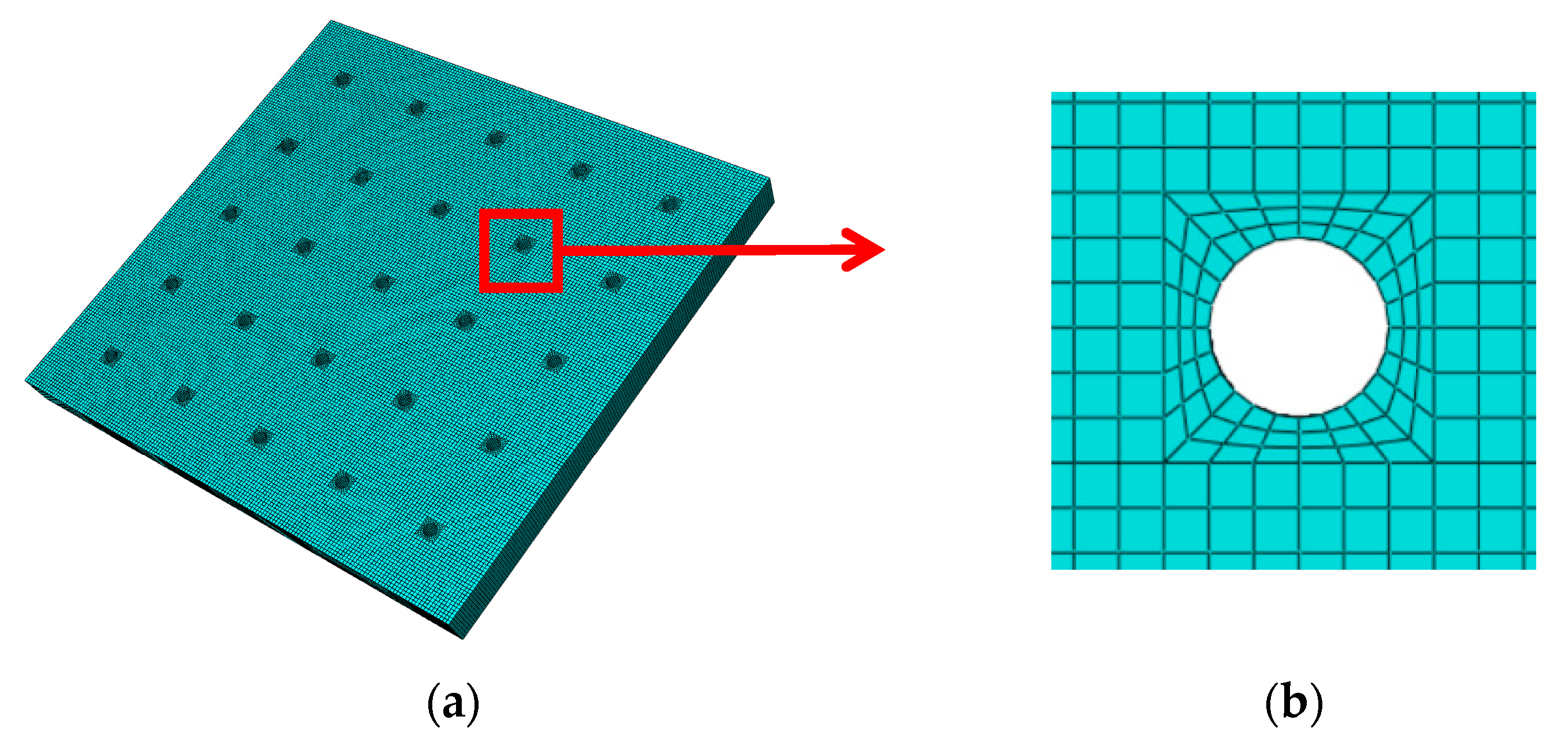
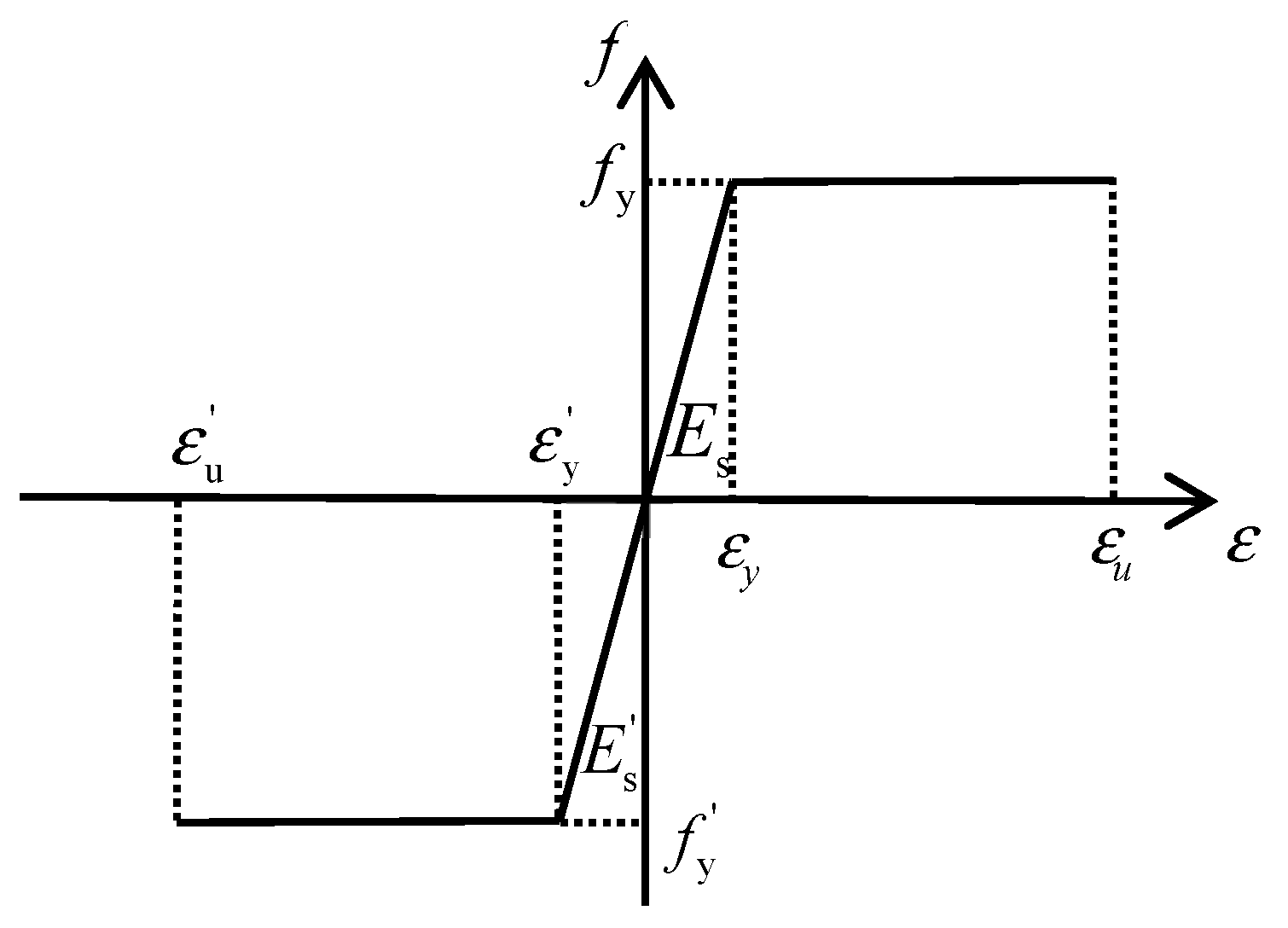
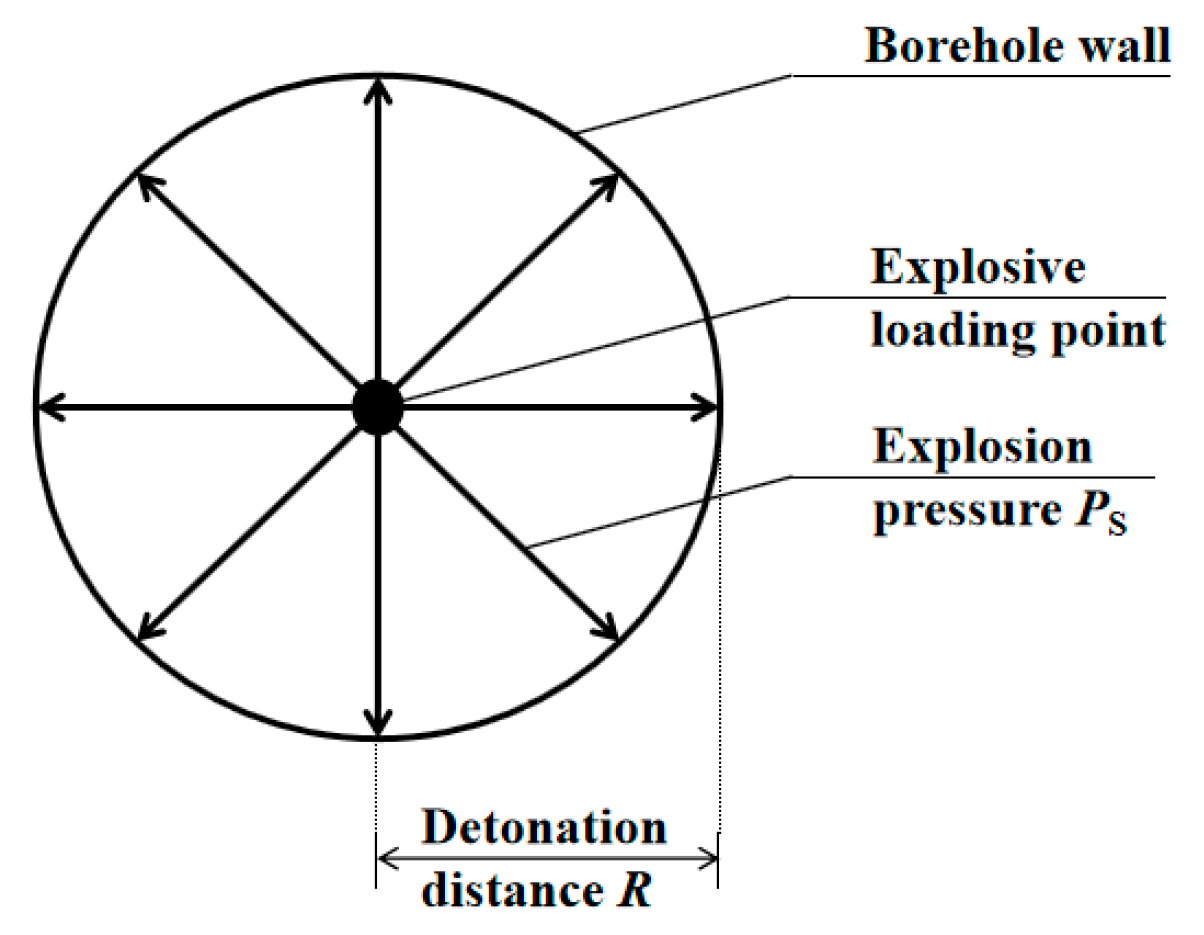





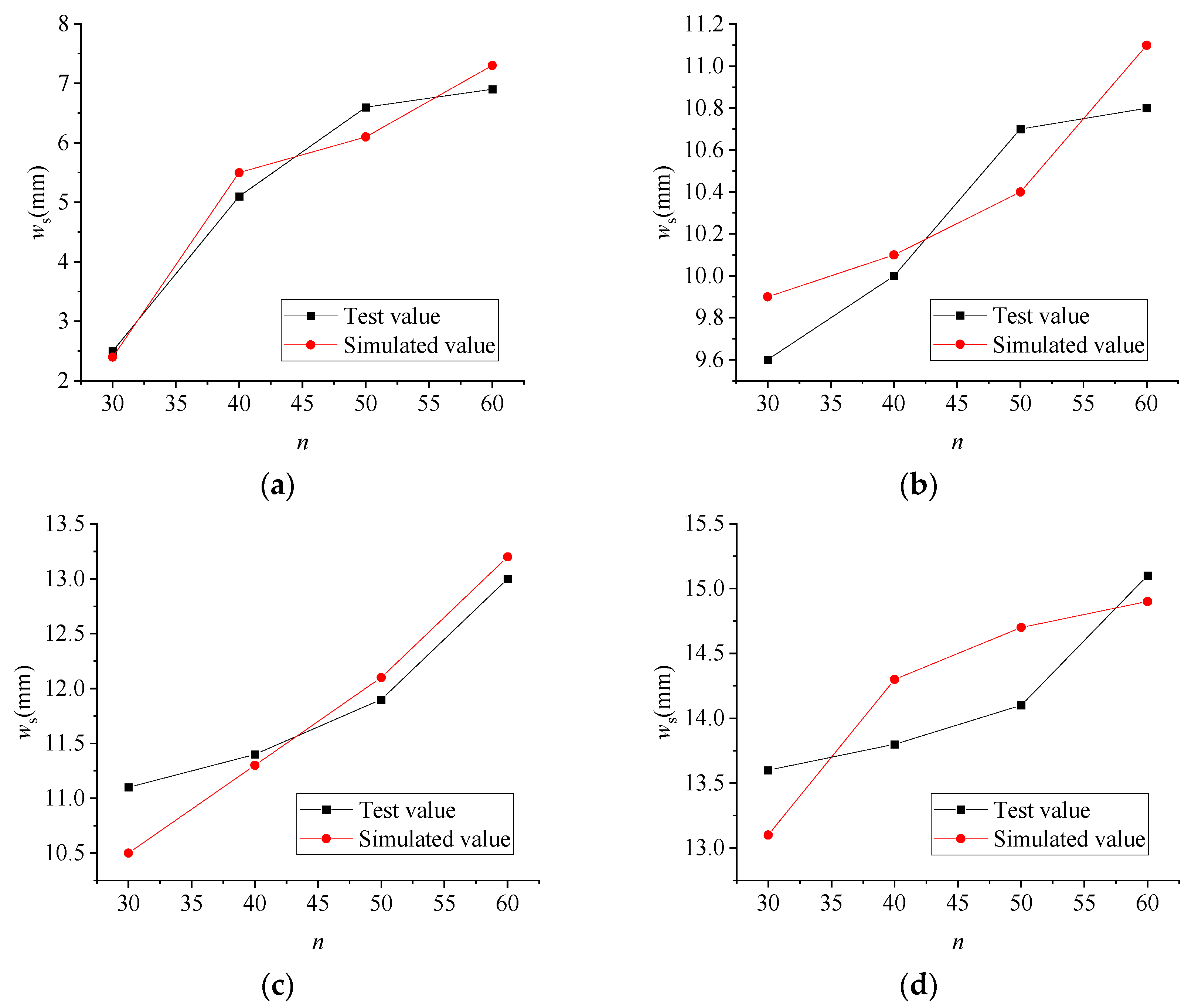

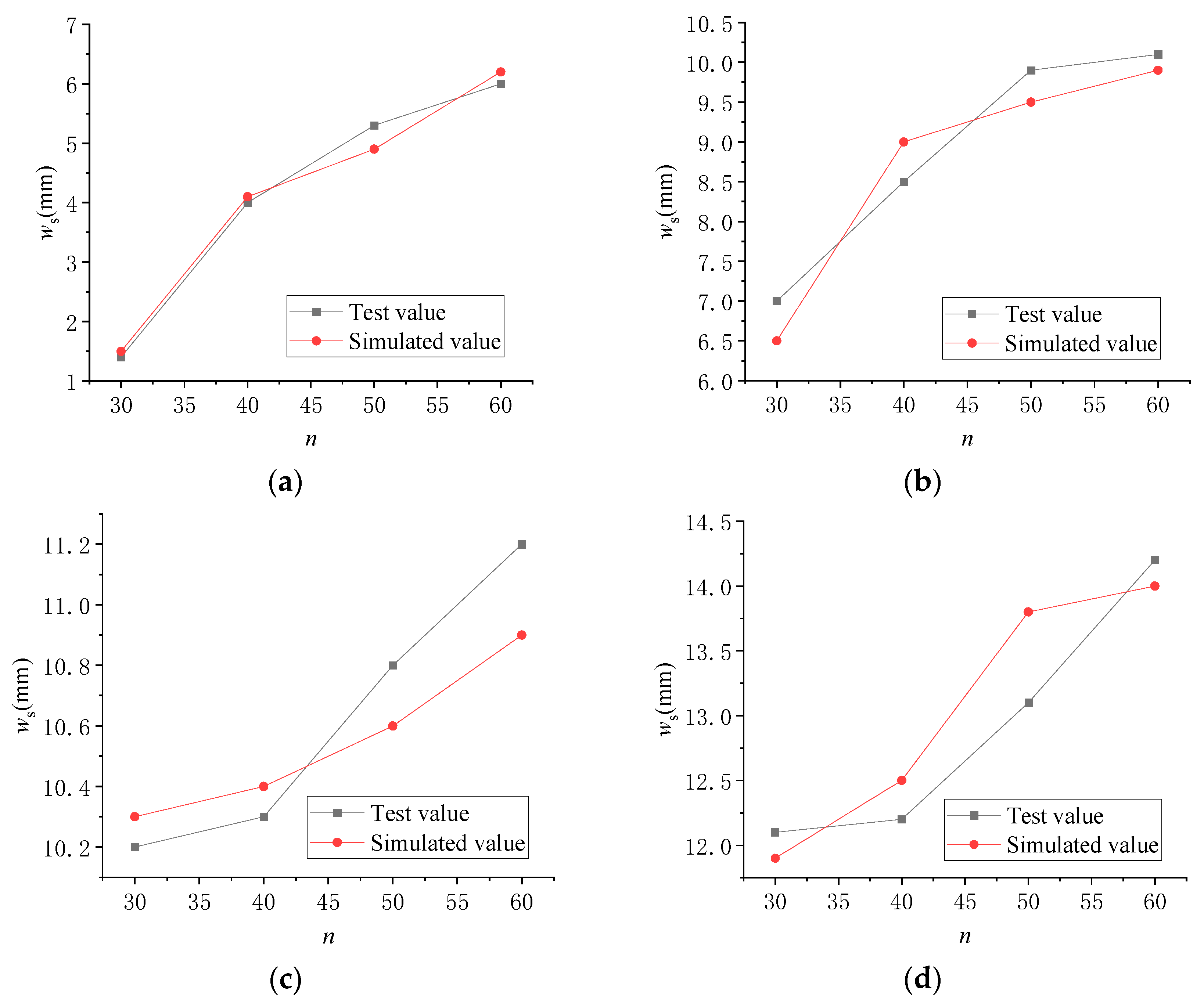
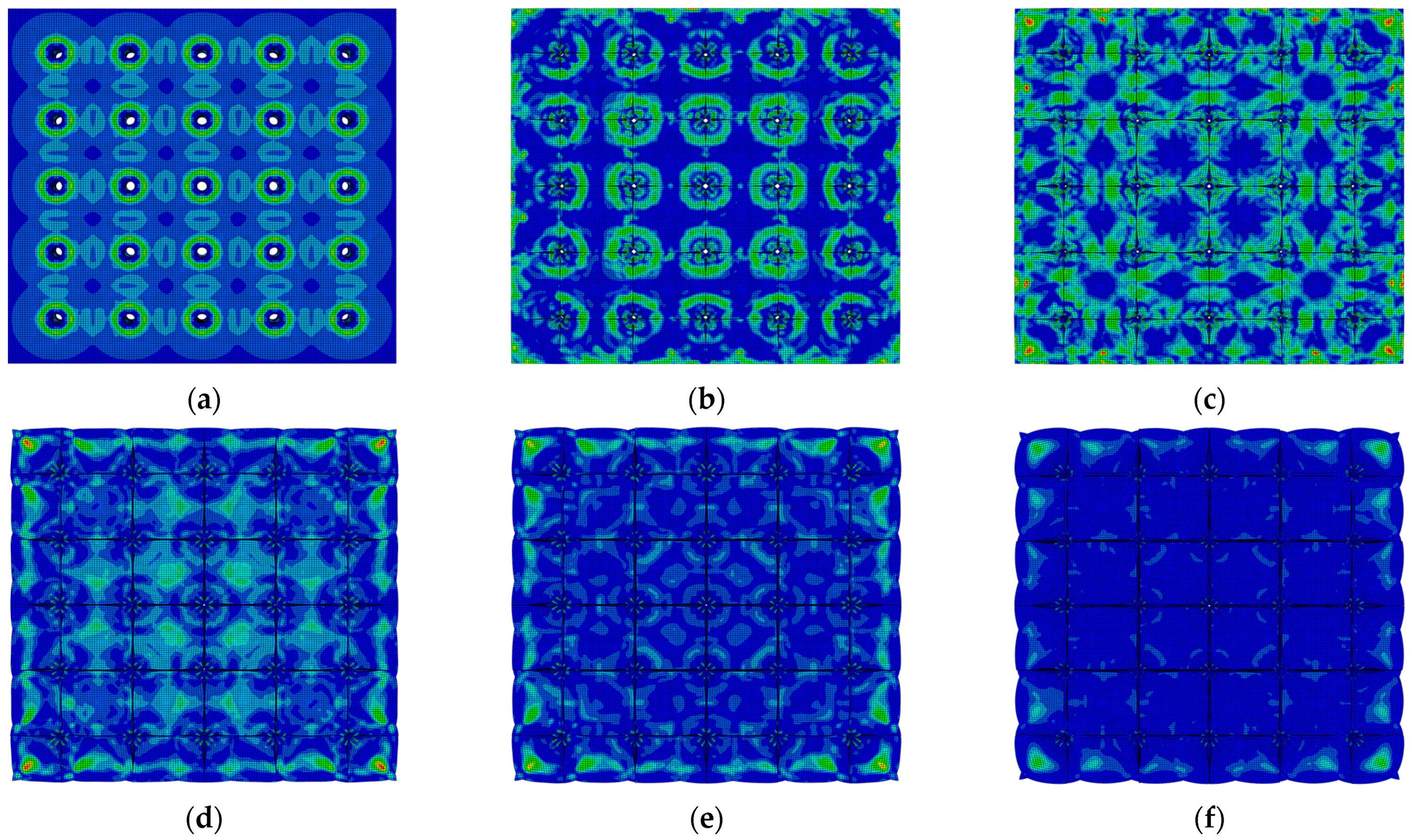
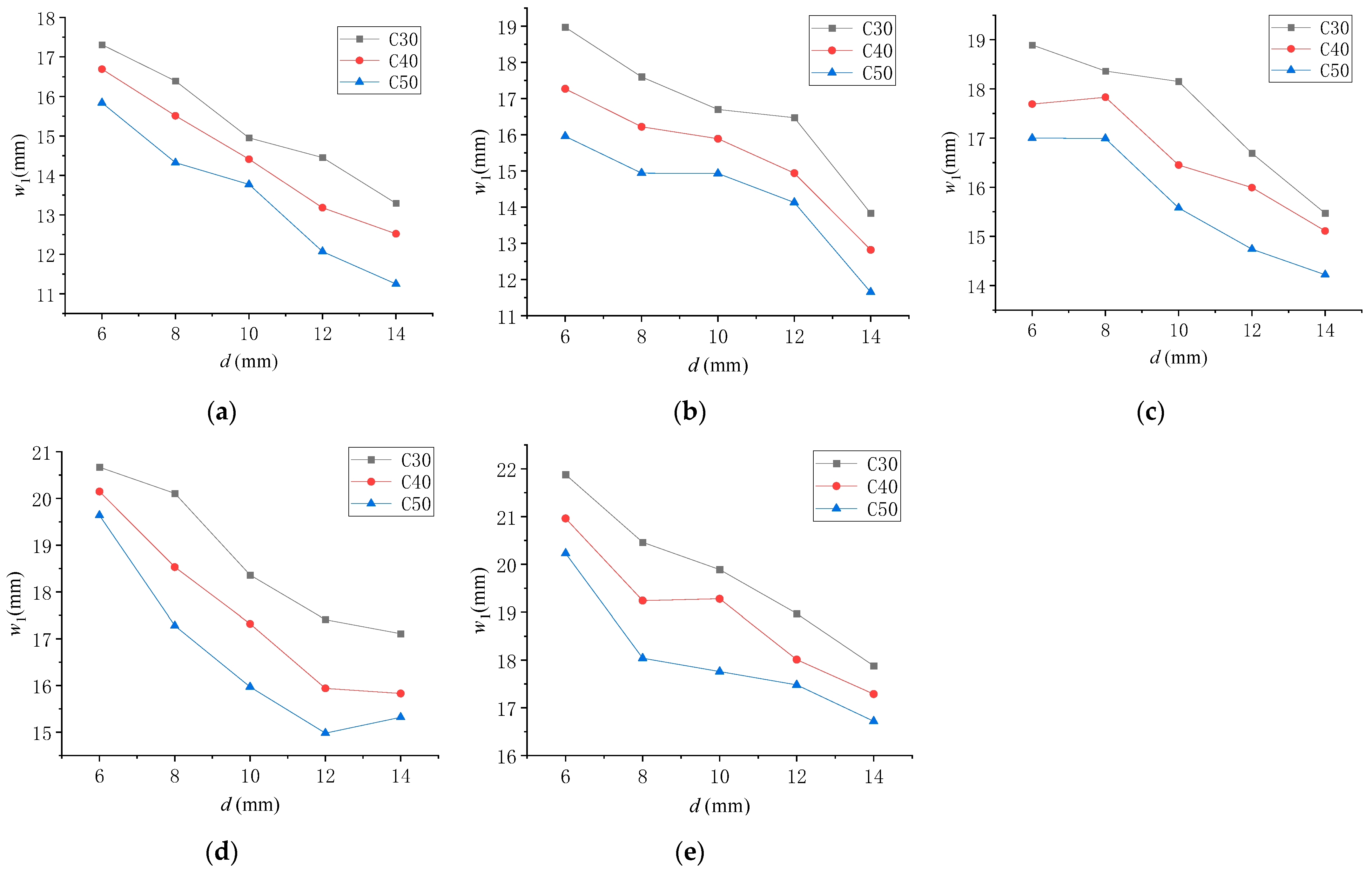
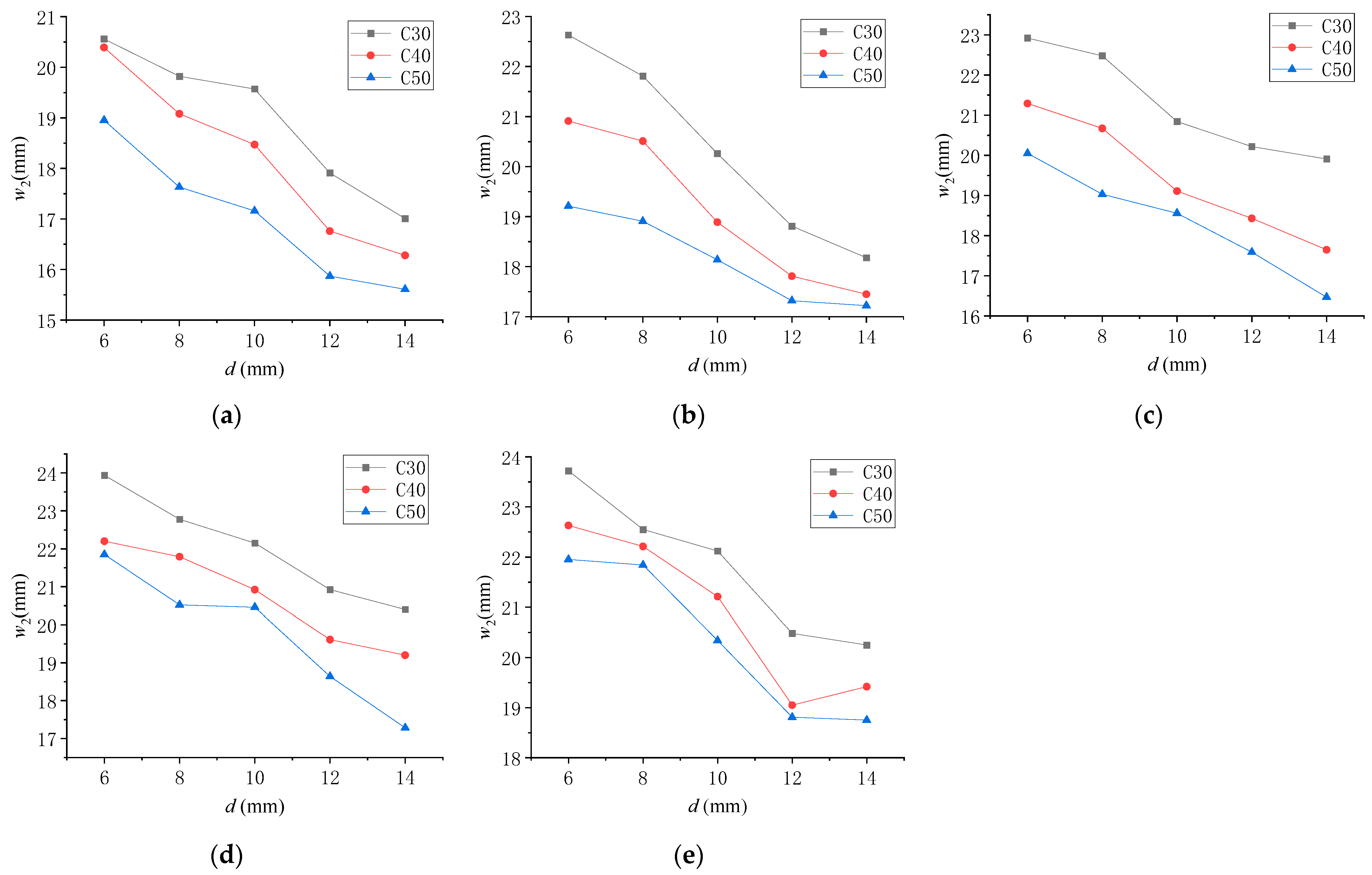
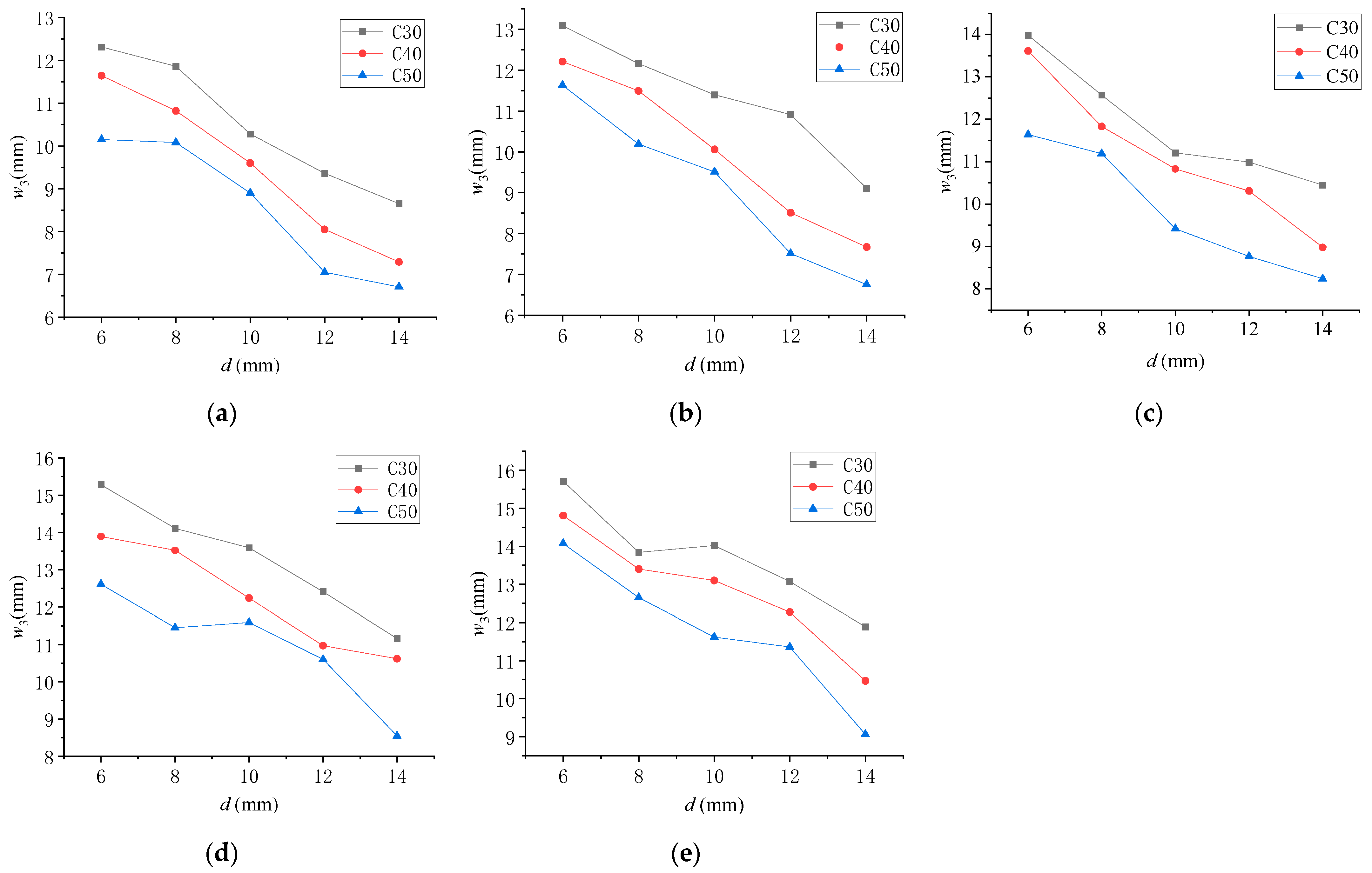


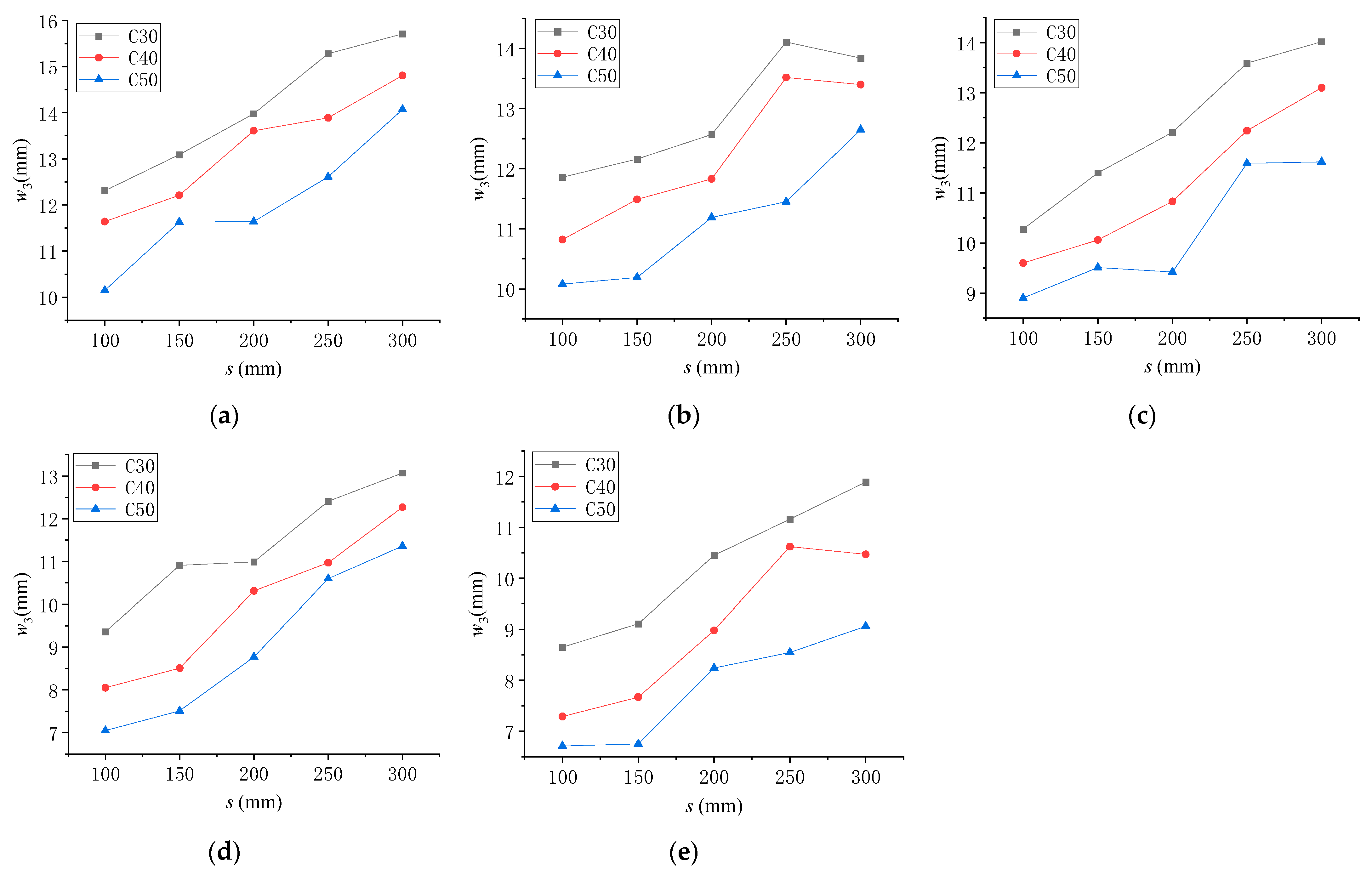

| Concrete Strength Grade | Compressive Strength of Cube/(MPa) | Compressive Strength of Prism/(MPa) | Tensile Strength of Prism/(MPa) | Elastic Modulus × 104 (MPa) |
|---|---|---|---|---|
| C20 | 25.6 | 19.5 | 1.9 | 2.83 |
| C30 | 34.6 | 26.1 | 2.5 | 3.14 |
| C40 | 44.3 | 30.9 | 2.7 | 3.20 |
| Steel Types | Tensile Yield Strength/(MPa) | Ultimate Tensile Strength/(MPa) | Modulus × 105/(MPa) |
|---|---|---|---|
 | 331.9 | 510.6 | 2.43 |
| Crack Width | Concrete Strength Classification | α | β | γ |
|---|---|---|---|---|
| Width of edge cracks w1 | C30 | 0.02 | 36.96 | 9.61 |
| C40 | 0.02 | 36.29 | 8.92 | |
| C50 | 0.02 | 38.21 | 7.68 | |
| Width of cracks between edge holes w2 | C30 | 0.01 | 38.26 | 13.75 |
| C40 | 0.01 | 38.41 | 12.66 | |
| C50 | 0.02 | 34.65 | 11.67 | |
| Width of cracks between central holes w3 | C30 | 0.02 | 37.58 | 4.67 |
| C40 | 0.02 | 42.99 | 2.86 | |
| C50 | 0.02 | 41.31 | 2.26 |
Disclaimer/Publisher’s Note: The statements, opinions and data contained in all publications are solely those of the individual author(s) and contributor(s) and not of MDPI and/or the editor(s). MDPI and/or the editor(s) disclaim responsibility for any injury to people or property resulting from any ideas, methods, instructions or products referred to in the content. |
© 2024 by the authors. Licensee MDPI, Basel, Switzerland. This article is an open access article distributed under the terms and conditions of the Creative Commons Attribution (CC BY) license (https://creativecommons.org/licenses/by/4.0/).
Share and Cite
Lin, X.; Yang, F.; Liu, Y.; Yang, Y. Research on the Crushing of Reinforced Concrete Two-Way Slabs by Pulse Power Discharge Technology. Buildings 2024, 14, 1222. https://doi.org/10.3390/buildings14051222
Lin X, Yang F, Liu Y, Yang Y. Research on the Crushing of Reinforced Concrete Two-Way Slabs by Pulse Power Discharge Technology. Buildings. 2024; 14(5):1222. https://doi.org/10.3390/buildings14051222
Chicago/Turabian StyleLin, Xinxin, Fei Yang, Youwei Liu, and Yang Yang. 2024. "Research on the Crushing of Reinforced Concrete Two-Way Slabs by Pulse Power Discharge Technology" Buildings 14, no. 5: 1222. https://doi.org/10.3390/buildings14051222





